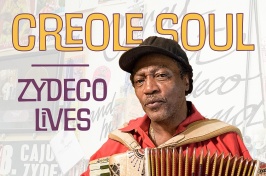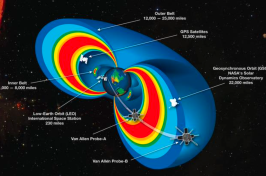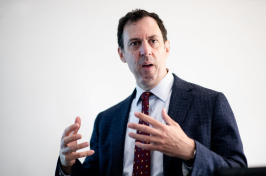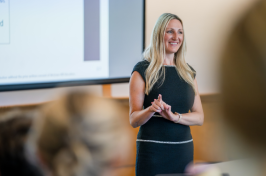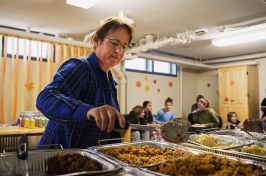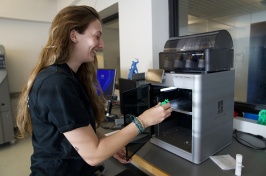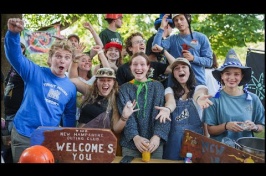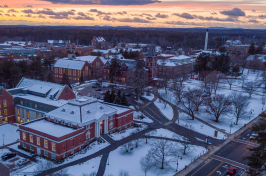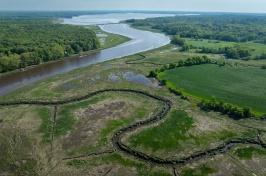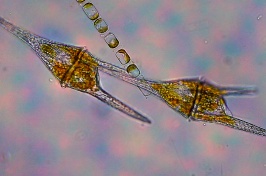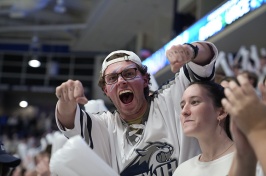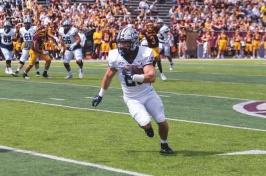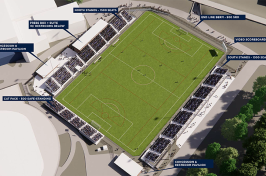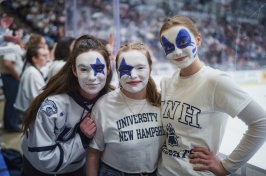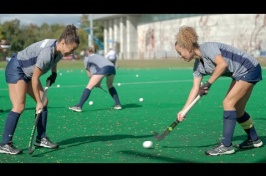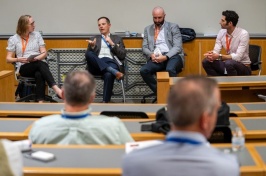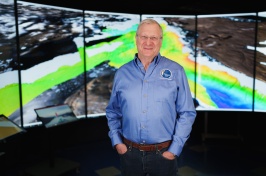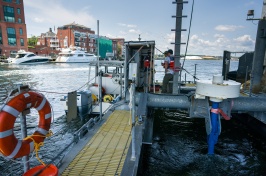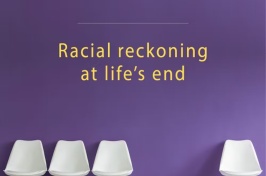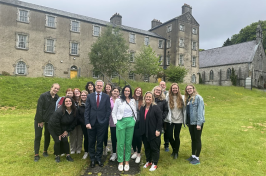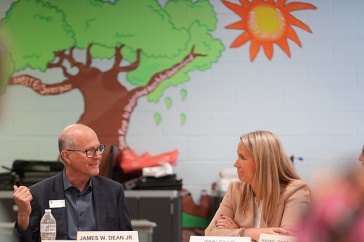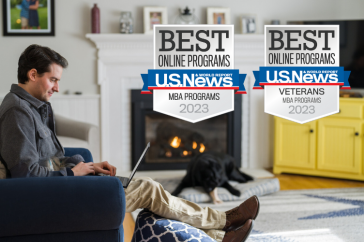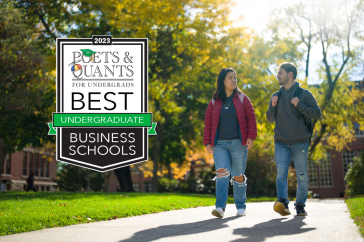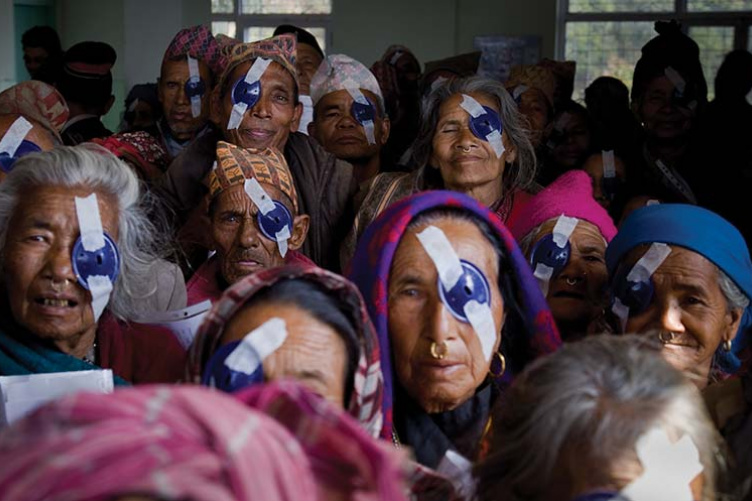
Photo courtesy of Job Heintz '90
When Job Heintz ’90 looks back on his time at UNH, one lesson in particular stands out. He had walked onto the varsity hockey team after a successful high school career, with high hopes that gradually gave way to realism. “By the end of my first year, I realized I wasn’t going to be a star goaltender, not for UNH and not for the NHL,” he says. Thanks to assistant coach Sean Coady ’81, however, this dose of reality went down surprisingly well. “He had the ability to help you understand that just because you’re not going to achieve your original dream, that doesn’t mean you can’t excel and do a lot of great things,” recalls Heintz. “Things happen that you can’t control, but you just have to work hard and keep moving forward.”
Coady went on to become a professional scout and director of player personnel with two teams in the National Hockey League. Heintz has gone on to make major contributions in a totally different arena: helping citizens in one of the world’s poorest countries protect their environment and leading an international nonprofit that has cured blindness for hundreds of thousands of people in developing nations worldwide.
As Heintz let go of the hockey dream, his first step on a new path was finding a completely different athletic challenge — exploring the rock walls of New Hampshire and Maine. He took a rock-climbing course at UNH and developed what would become lifelong friendships with his classmates while “cragging” at Cathedral Ledge, Crawford Notch and nearby Pawtuckaway State Park. After graduating with a degree in English, he spent two years climbing, writing and training outdoor enthusiasts as a National Outdoor Leadership School instructor, ultimately leading expeditions in Alaska, British Columbia and the Indian Himalayas.

In 1995, Heintz earned both a J.D. and master’s degree in environmental law at Vermont Law School, where he had been required to do a legal internship. Instead of following the beaten path to an internship at, say, the EPA, he connected with a lawyer working on democratic reforms in Nepal and traveled to Kathmandu. “I wanted to see the Himalayas, and I did get into the mountains,” he says, “but 90 percent of my time was spent on the backstreets of Kathmandu, seeking out like-minded Nepalese public interest lawyers.” While he was there, he co-founded the country’s first public interest environmental law firm, Pro Public.
For the better part of the next decade, Heintz hopscotched between the East Coast and Kathmandu, working as an environmental advocate in Vermont and lending his expertise as a volunteer to Pro Public, which has won an impressive number of environmental cases before the Nepalese supreme court. After 9/11 foiled a planned move back to Asia, Heintz and his wife, Cristina Pellechio ’89, moved to the Mid-Atlantic region. Within a year they were expecting their first child, and in 2003 they moved back to Vermont. “We knew we wanted our kids to grow up with wilderness, as well as family, nearby, but it was taking a big economic risk,” says Heintz. He was hired — part time at first — by world-renowned mountain climber and ophthalmologist Geoff Tabin at the Himalayan Cataract Project, which was headquartered in Vermont. Tabin and Sanduk Ruit, a Nepalese ophthalmologist, had started the nonprofit eight years earlier to bring state-of-the-art eye care and surgery to destitute populations in remote areas in Nepal. Now they needed someone with a strong business sense to help scale up their organization so they could carry out their mission of “reaching the unreachable” in other countries as well.
“I wouldn’t say we were exactly ‘cowboy ophthalmologists,’” recalls Tabin, who had been more or less handling the office work out of a box in the back of his car, “but we needed someone to harness our energy and focus.” Heintz filled the bill on multiple levels, ramping up public relations, garnering large grants from the U.S. government, structuring the organization, and keeping an eye on legal requirements
as well.
Tabin and Heintz soon found that some of their best work together got done in the wilds of Vermont. “About once a week we’d meet at a quarry,” Tabin recalls, “and discuss how to expand eye care into Bhutan while we were belaying each other on frozen waterfalls, or rock climbing.” Tabin has since relocated to Utah, but wherever the duo’s work takes them, they continue to strategize in a sort of extreme form of the office “off-site”—running a half marathon in Ethiopia (a fundraiser for the nonprofit), scaling cliffs in Burma or rock climbing in Utah.
Within a few years, Heintz became the CEO of the Himalayan Cataract Project. With an annual budget of more than $5 million today, the organization has increased in size tenfold under his leadership. The office is no longer entirely virtual, but it remains very modest — located in a former church parsonage that also houses a food pantry in Waterbury, Vt. — and the organization prides itself on the unusually low proportion of its budget, just 10 percent, that goes to administrative costs. It’s all part of HCP’s commitment to providing the most help to the most people at the lowest cost. For those individuals, the results can only be described as priceless.

Because of poor nutrition and other factors such as a genetic predisposition and increased exposure to ultraviolet light from time spent outdoors and at high altitudes, the prevalence of cataracts is especially high in a country like Nepal. Worldwide, millions of people who don’t have access to care needlessly lose their vision to cataracts every year, and the consequences of blindness are much more dire in less-developed countries. On average, a blind person’s life expectancy in these regions will be less than one-third that of a healthy person of the same age.
In some poverty-stricken areas, the HCP doctors often note, a blind member of a family may be regarded as “a mouth with no hands.” One Ethiopian grandmother describes how that feels: “Sometimes I hear my daughter praying that I will die so she can take care of her own children instead of me. I don’t blame her. Sometimes I think death would be better than this.” The grandmother was interviewed for a documentary about one HCP high-volume cataract-surgery campaign, in which a multinational team of five surgeons spent a week in a small rural hospital, removing more than 1,300 cataracts.
Although Heintz spends most of his time managing a staff of 10 and more than two dozen partnerships on three continents, he helps out at high-volume campaigns like the one in Ethiopia several times a year. Thanks to a sutureless form of cataract surgery developed by Ruit, HCP’s Nepalese co-founder, and an innovative and inexpensively produced artificial lens he developed, the surgeries can take place in rapid assembly-line fashion, in makeshift operating rooms. In places like Nepal or Bhutan, the doctors and their staff and porters may spend many days on foot climbing high into the mountains, pressing on at night by the light of headlamps and carrying in equipment like microscopes and slit lamps.
When Heintz arrives with the ophthalmologists, hundreds of patients have already been waiting at the site, sometimes for days. He relishes the opportunity to get involved, speaking to patients in their own language with the help of local nurses who provide a list of key phrases. The patients come out of the 10-minute operation with patches on their eyes and wait only till the next day for the moment of uncovering — and revelation.
“In all these different places in world, it’s always the same experience,” says Heintz. “The patient’s eyes are reacting to light all of a sudden, after maybe eight or 10 years. So first there’s a moment of ‘what?!’”
The next reaction often varies by culture. There may be laughter, tears or shouts of joy. In Ethiopia, ululations. In Burma, Heintz recalls, “people just blinked. They didn’t know quite how to react. In North Korea, patients turned toward the portrait of the Great Leader on the wall, praising him instead of the doctor who had removed their cataracts.” Back home in her village, the Ethiopian grandmother in the documentary is thrilled to be able to cook, clean and help with her grandchildren. Now “no one is praying for me to die,” she says. “Especially me.”
It’s all possible because of a $25 version of an operation that costs roughly $4,000 in the United States. Over the past decade, HCP and its partners across Asia and Sub-Saharan Africa have performed some 365,000 sight-restoring cataract surgeries in hospitals and outreach field settings in more than a dozen countries. But the project doesn’t stop there. Many other eye injuries and diseases are treated, both in the field and at the Tilganga Eye Center in Kathmandu. Heintz secured funding for and directed a multimilion-dollar expansion of the center, which is an HPC partner institution. Together, HCP and Tilganga have funded new facilities in remote, poverty-stricken areas and trained more than 500 ophthalmologists and thousands of nurses and technicians from more than 40 countries in the high-volume cataract-surgery methods perfected by Ruit and his team.
There seems to be a natural metaphor in the path Heintz’s career has followed, from rock climbing to supporting an organization that strives to surmount any obstacle in its mission to bring the light of sight — and life — to the poorest of the poor. But he rejects the easy “climb every mountain” analogy and speaks instead of parallels between his work today and the work he did planning and leading alpine expeditions for the National Outdoor Leadership School. “There is a process of risk evaluation that’s going on all the time,” he says. “You’re constantly looking at the weather, at how much food you have, at how fast moving that river is, and at the team’s level of skill. And if we’re not prepared for the objective hazards, we’re turning around no matter what. We plan our sight-restoring surgical outreach events with the same attention to detail.”
Perhaps a better metaphor for his role in HCP is the climbing expression “sharing the rope” — literally being there for someone else who may suddenly be dangling from a rope that you’re holding, whose very life depends on your strength, skill and good judgment. He did that with his peers in the UNH rock-climbing course and still does it whenever he and Geoff Tabin scale frozen waterfalls together.
The Himalayan Cataract Project has received a lot of attention in recent years, as the subject of documentaries on National Geographic TV, ABC’s “World News Tonight” and “Nightline,” as well as numerous magazine articles and a 2013 book called Second Suns: Two Doctors and Their Amazing Quest to Restore Sight and Save Lives. Virtually all of the press has focused on the accomplishments and dedication of the doctors, who often do 12-hour shifts in their makeshift operating rooms. (Ruit alone has performed over 100,000 sight-restoring surgeries.)
That’s exactly as Heintz would have it. These doctors are, clearly, heroes. But they wouldn’t be able to accomplish all they do without a behind-the-scenes leader who can provide the financial, strategic and legal support they need. In other words, someone like Job Heintz, whom they can trust to share the rope.~
EARTHQUAKE RELIEF: In the wake of the 7.8-magnitude earthquake that devastated Nepal on April 25, the Himalayan Cataract Project began providing help with eye and head trauma cases in Kathmandu and started sending aid out to the villages through its partner, Tilganga Eye Institute. HCP has subsequently raised more than $375,000 in funds devoted 100 percent to providing food, water, water treatment, shelter and medical care in Kathmandu and four of the most devastated outlying districts. To make a donation to HCP, either for sight-restoring surgeries in developing nations or to help with earthquake relief, visit https://donate.cureblindness.org/
Virginia Stuart ’75, ’80G is a freelance writer who spent more than a decade as an associate editor of UNH Magazine. Her feature stories have won national silver and gold medals from the Council for the Advancement and Support of Education.
Originally published in UNH Magazine—Spring/Summer 2015 Issue
-
Written By:
Virginia Stuart '75, '80G | Communications and Public Affairs






